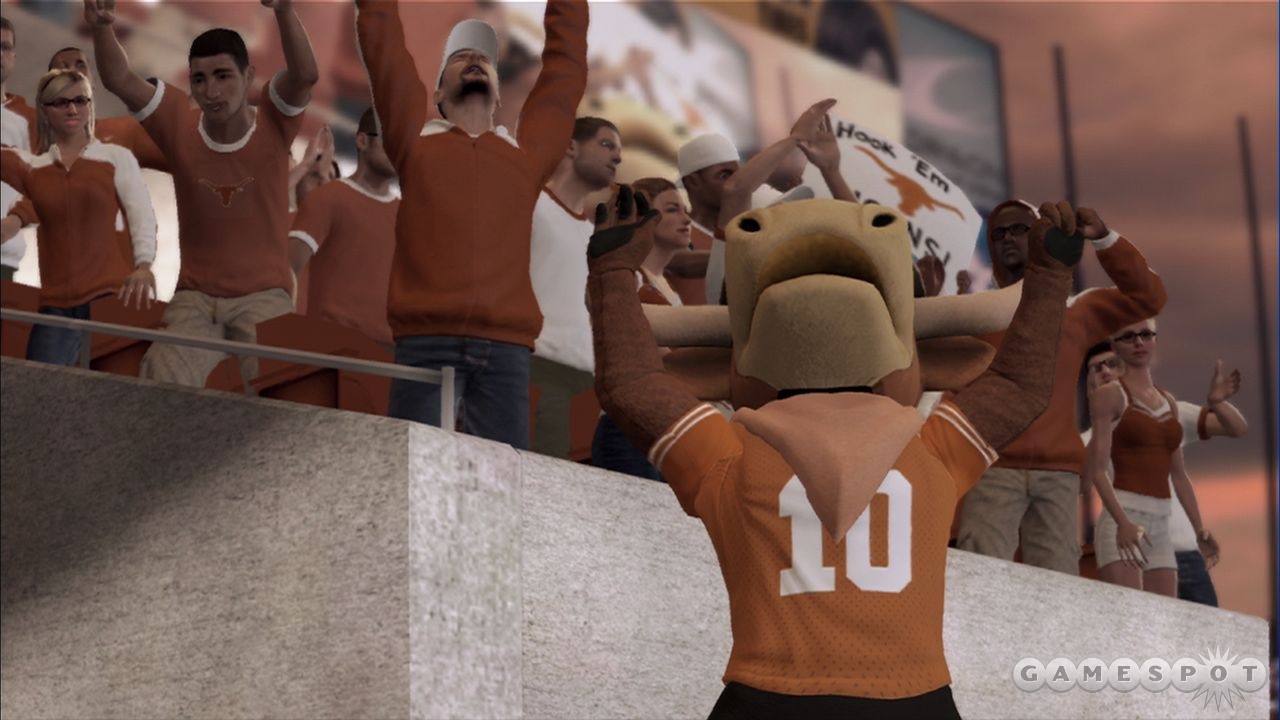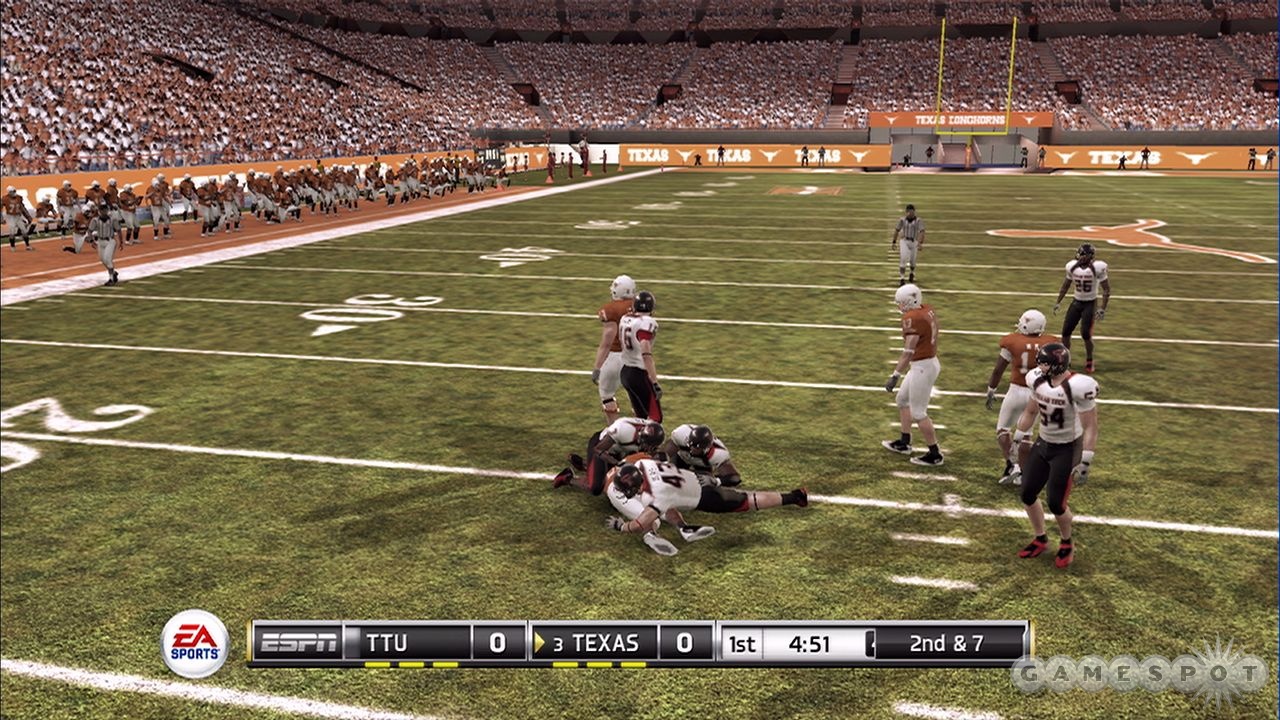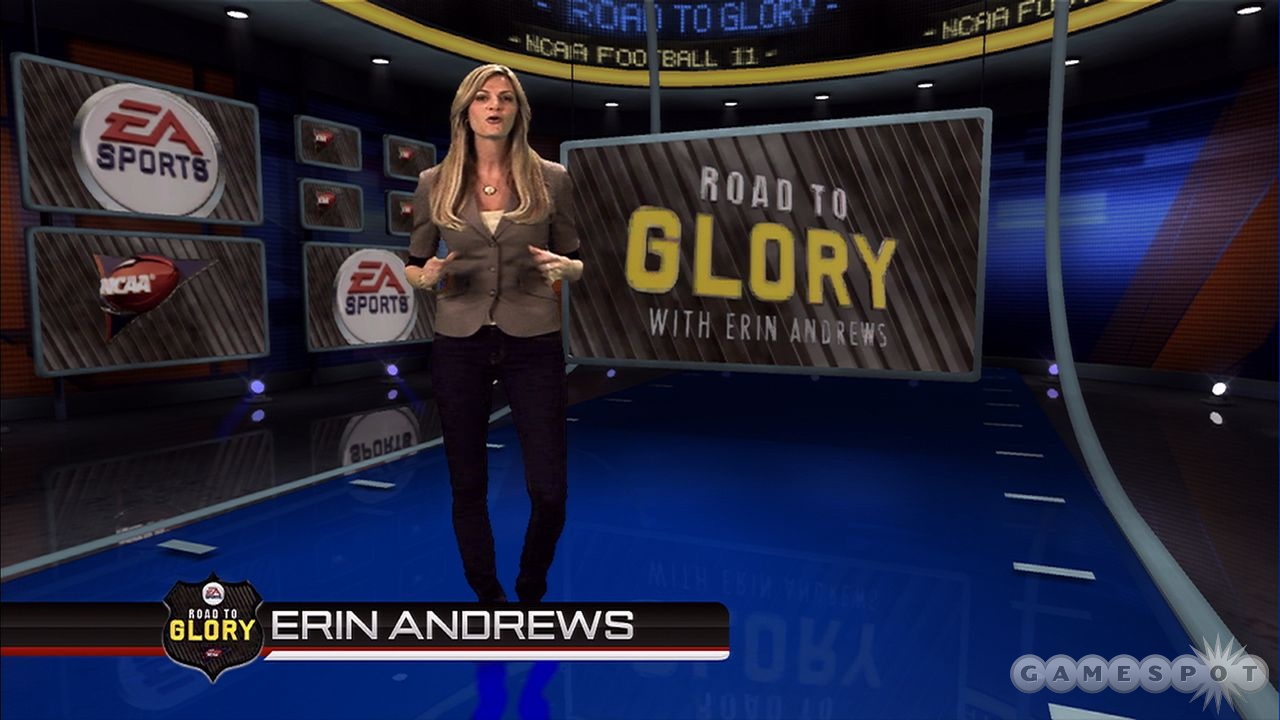NCAA Football 10 made some significant strides last year by introducing some entertaining new modes and reworking old ones to flesh out the entire college football experience. This year, EA Sports took a different approach with NCAA Football 11 by focusing more on beefing up on-field action than on making major in-game upgrades to supplementary modes like Road to Glory. But, that's not to say these preexisting modes--those transferred from last year to this year--are completely neglected. There are some small changes to be found, some of which don't amount to much more than window dressing while others succeed in making their associated modes more engaging.
In either case, it's disappointing to start up a mode in NCAA Football 11 and find that little has changed, and there's no greater offender than the Road to Glory mode. This is the mode where you can create your own player and watch him grow from a high school standout to a college superstar. It's still hosted by ESPN's Erin Andrews, and colleague Kirk Herbstreit still chimes in to break down your performance, but aside from game specific highlights that play during his postgame recaps, there isn't anything specific to this mode that you haven't already seen if you played NCAA Football 10. Even Andrews' appearance is simply a replay of what she did for the previous game. Still, there's something undeniably addictive about taking a no-name player and turning him into a star athlete, but like last year, you still have to be mindful of the pitfalls of selecting certain positions on offense. For example, quarterbacks can always call an audible to get out of predetermined plays, but running backs and receivers are still at the mercy of an AI-controlled coach that wants to win and doesn't care about your individual performance.
NCAA Football 11's Dynasty mode is disappointing, at least in terms of feature upgrades from last year, but there's one relatively small difference beneath the surface that improves a major aspect of managing any dynasty, and that's recruiting. Like the recruiting methods found in previous NCAA games, you can woo an athlete to your school by making phone calls and pitching the benefits of joining your program. But NCAA Football 11 turns these phone calls into a more engaging and obvious meta game where you can earn points (think of them as indicating the level of interest in your school) and cause other schools to lose points based on the topics of discussion. For example, if you're talking about coaching prestige and your school has a high rating whereas a competing school has a slightly lower rating, then the recruit will show greater interest in your program and less interest in the other. Comparing the two schools will earn you points that reflect the recruit's interest. At times, recruiting still feels like an impenetrable wall of information, but receiving an instantaneous (and easily understood) reward for your efforts and having greater transparency in the recruitment process make it more worthwhile.
That feeling is amplified when playing an online dynasty where you can actively try to take prospects away from other player-controlled schools and hear competitors whine about it. But an online dynasty offers another significant advantage over its single-player counterpart in the form of a Web-based interface where you can access your dynasty at any time via a PC. Easily one of NCAA Football 11's greatest non-gameplay improvements, this interface not only lets you view schedules and keep tabs on other teams, but it also lets you participate in recruiting (which functions much as it does in the actual game) and write up news stories or messages on your games that are then posted to a dynasty-specific blog with highlights that you can share through a variety of social-networking options. This is an absolutely great tool for playing up the competitive element of a multiuser dynasty, and it goes a long way in making the entire dynasty process more seamless. It does, however, have a few technical hiccups every now and then as the site sometimes isn't available or it can take a good chunk of time to load a dynasty, but it's a great way to kill some time when it works.

Of course, none of this would matter if NCAA Football 11's gameplay wasn't any good, but thankfully, it builds off of many of the improvements from last year and makes some progress in becoming an even more accurate representation of college football. The running game feels great thanks to some improved right-analog stick controls that finesse player movements--how far you press right, left, back, or forward determines just how much you sidestep or put your momentum forward or backward, which is more useful in one-on-one situations as opposed to stomping through the defensive line. Also, because of improved collision detection between players, there's a much greater feeling of being able to fend off a tackle with a spin or stiff arm if you're timing is right. That being said, there's still some questionable run blocking as it's not completely uncommon to see a lineman or receiver run back toward the line of scrimmage instead of make a downfield block on a defensive back or linebacker, but it's certainly improved over last year. There are also moments when running backs (albeit very good ones) seemingly gain superhuman strength and shed tackles from 250-plus pound linebackers as if they were drops of water.
NCAA Football 11's passing game has some similar quirks that are mostly just unrealistic. Two receivers running a slant route across the middle of the field run into each other far too often, thus disrupting the timing on a pass. It's not unreasonable to see this happen once in a long while, but its frequency suggests that these receivers probably shouldn't be playing football. Likewise, there's some inconsistency with the long ball. Normally, if a receiver is unable to reliably make a catch on a short six-yard route, you wouldn't necessarily expect him to make the catch on a 40-yard pass, but it happens--more than it should. On top of all that, quarterbacks can still make some ridiculous throws when scrambling, specifically when running to one side of the field and throwing the ball in the opposite direction against their natural motion. Still, the quality of the defensive AI really forces you to make smart decisions about where to throw the ball, and the fact that receivers generally try to stay in bounds (thanks to some new feet-dragging animations) when catching the ball near the sidelines opens some new opportunities, especially when the clock is ticking and you're close to winning a game. At any rate, it's a great feeling to read coverage and pick it apart with a smart pass.

There isn't much to complain about when it comes to the defensive side of the ball. There are those aforementioned moments where a running back becomes a nearly unstoppable beast, but the most annoying hole in the defense is watching a defensive end stay put in a coverage zone when he's about five feet away from the quarterback and can easily get a sack. But, all around, defense tends to play in a very smart way, and when you normally wouldn't expect them to, defensive backs and linebackers do a great job of swatting down passes.
It's worth pointing out that on both offense and defense, NCAA Football 11 tries to make play calling as easy as possible for those who might not understand the intricacies of the sport or just want to rush things along. As such, before the snap, you immediately have access to several plays that are based on your on-field location, down, and yardage-to-go for the first down. These initial plays are useful (and less time consuming) if you're aiming for some bread-and-butter-style options, such as running plays up the middle or uncomplicated passing plays, but most veterans will find these options limiting as the game progresses and opt for the classic mode of play calling instead. What's also interesting about NCAA Football 11's play calling system is just how differently computer-controlled teams play from one another based upon their real-world counterparts. If you're playing against a school that primarily goes no huddle, then that's what you get in-game. This keeps individual games interesting as you adjust your strategy to meet a school's characteristics and tendencies.
If you're going up against other players online, you might not experience the same thing because human-controlled opponents generally play the game the way they want to, no matter what. In general, online games are relatively lag free, but there is a noticeable delay for kickoffs and any other situations that use the kicking meter. In addition, some players may jump around the field a bit if your connection isn't completely solid, but otherwise, online games generally happen without any significant hitches.
As for presentation, NCAA Football 11 delivers some nice visual upgrades in the form of much improved lighting (which occasionally freaks out during late-afternoon games when the lighting randomly switches after the end of the half), slightly more detailed character models, and greater ESPN integration. Some teams also have field entrances that are based on their real-life counterparts, such as Notre Dame's entrance where players slap the sign as they make their way onto the field. There are also crowd-specific animations for teams like the Florida Gators, which will show its fans doing the chomp motion with their arms. Rounding out the entire experience is the commentary team of Brad Nessler and Kirk Herbstreit (no Lee Corso this year, to the delight or dismay of many) with Erin Andrews issuing sideline reports. The team does a decent job of calling the on-field action in an accurate--if not completely enthusiastic--way, but it often seems like the commentary just can't keep up if the action is moving at a steady clip.

There's always an issue with sports games when it comes to deciding whether or not the additions in the current year's game are enough to warrant a purchase for those who bought the previous year's game. At first glance, NCAA Football 11 doesn't seem like it offers much in the way of new content, which might not make it the best option for fans that want major upgrades to extra modes from year to year. But whether you're participating in an online dynasty and its new Web interface, creating your own team in the excellent TeamBuilder mode carried over from last year, or just experiencing some great changes to the gameplay, there's plenty of content and under-the-hood changes here for the most rabid college football fan to enjoy.